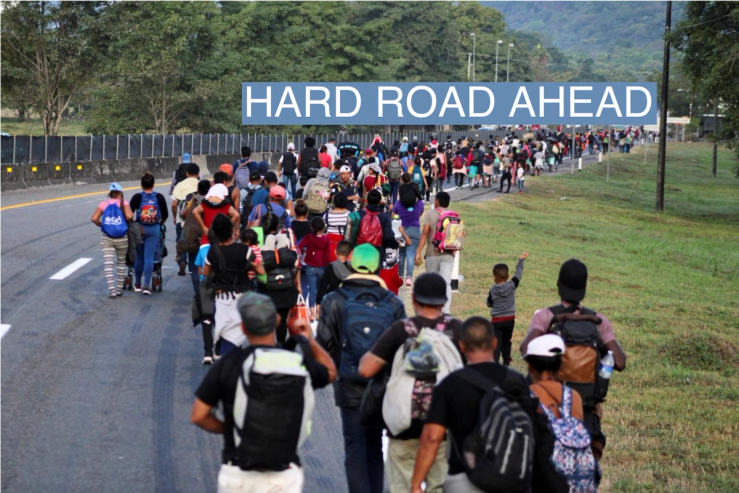The News
If Washington can reach a deal on the border, its success or failure could ultimately depend on the reaction in Mexico City.
The U.S. already relies on Mexico to help expel migrants from countries such as Honduras, Colombia, Guatemala, and Venezuela, mostly for logistical reasons. The federal government lacks the fleet of planes and trained pilots necessary to deport more than a few hundred people daily, far below the roughly 10,000 migrant apprehensions on average per day in December at the Southern border.
As a result, it often sends migrants back to Mexico, and leans on the country’s government to carry out some repatriation flights; Mexico has recently restarted deporting Venezuelans in tandem with the U.S., for instance.
Any new law aimed at ramping up deportations would almost certainly need a new formal deal with Mexico to accept a new influx of foreign nationals back within its borders, according to lawmakers and immigration experts who spoke with Semafor.
Sen. Chris Murphy, D-Conn., said that foreign component is partly why a border agreement has proven “so complicated” to take shape during bipartisan negotiations in the Senate.
“If you’re creating new authorities, the reaction of your international partners matters,” Murphy told Semafor. “That’s why you can’t write an immigration reform bill with changes in border policy overnight. You have to be very careful about how it’s written. You have to factor in how partners, in particular the Mexican government, will react.”
Last month, Secretary of State Antony Blinken and Homeland Security Secretary Alejandro Mayorkas traveled to Mexico to meet with Mexican President Andrés Manuel López Obrador. A White House communique said both countries have “reaffirmed their existing commitments on fostering an orderly, humane, and regular migration.”
But Mexico seems to recognize it has leverage over the U.S., and it’s a presidential election year in both nations. López Obrador — who isn’t running for reelection — later laid out several demands in exchange for helping the U.S. curtail the flow of asylum seekers, including a pathway for 10 million undocumented immigrants to become U.S. residents, a $20 billion aid package for Caribbean and Latin American countries, suspending the U.S. blockade on Cuba, and rolling back U.S. sanctions on Venezuela. He has often criticized the U.S. for not shoring up relations with countries in the region to curtail mass emigration.
A delegation from the Mexican government is expected to visit Washington this month. In the meantime, House Republican leaders are already signaling that the deal currently under negotiation in the Senate would be dead on arrival in their chamber, highlighting the difficult road ahead for any potential bargain.
In this article:
Know More
Beyond providing flights, the U.S. has increasingly relied on Mexico and other Central American nations in the past decade to slow the flow of migrants fleeing extreme poverty, political meltdowns, and violence before they reach the southern border, according to Aaron Reichlin-Melnick, policy director at the American Immigration Council.
The Obama administration bolstered funding for Mexico to build up a security presence on its porous border with Guatemala, and Mexico attempted to dissuade Central American migrants from making the journey north by building more checkpoints. However, the effort attracted criticism from human rights groups who said government corruption and smugglers adept at shifting their networks had endangered migrants.
That basic arrangement hasn’t changed under the Biden administration, as border encounters have spiked to record highs. However, Mexico is both erecting migration barriers and clearing others. It has imposed new visa restrictions on certain nationalities, while establishing a program identical to the U.S.′ that admits people from Cuba, Haiti, Nicaragua, and Venezuela on humanitarian grounds.
“They have to be able to say that they’re not just doing the American government’s dirty work, but they’re actually advocating for increased legal pathways to the United States,” Andrew Selee, president of the Migration Policy Institute, told Semafor. “I think López Obrador is walking that fine line of being responsive to the U.S. government, but also not being seen as being anti-immigrant in a country where almost everyone has a relative living abroad.”
One Republican senator argued it’s in Mexico’s interest to forge an agreement now under President Biden. “If they don’t get it done this year and Trump wins, they’re gonna regret it next year,” Sen. Thom Tillis, R-N.C., who’s close to Senate border negotiations, told Semafor. “I really believe that and rightfully so. They got to help us fix this problem.”
Former President Trump often lashed out at Mexico over immigration during his first term. In 2019, he threatened to impose up to 25% tariffs on the country in a bid to pressure Mexico City into deterring the flow of asylum-seekers, mostly Central Americans, to the U.S.-Mexico border. Trump ultimately backed off, and Mexico agreed to expand the so-called “Remain in Mexico” program mandating some non-Mexican nationals wait in Mexico until their asylum cases were resolved. (The Biden administration later ended the initiative).
The View From Sen. Alex Padilla
In an interview with Semafor, Padilla pointed to a recent drop in the number of illegal border crossings as a sign that enhanced cooperation with Mexico is already paying dividends. But he said underlying factors driving migration flows like violence had to be addressed to find a durable solution at the border.
“They’re down because you’ve engaged with partners south of the border to do more management and enforcement. So that’s the way to do this sustainably and responsibly,” Padilla said. “We have to look at what’s driving so many people to want to come to the United States seeking asylum to begin with.”


